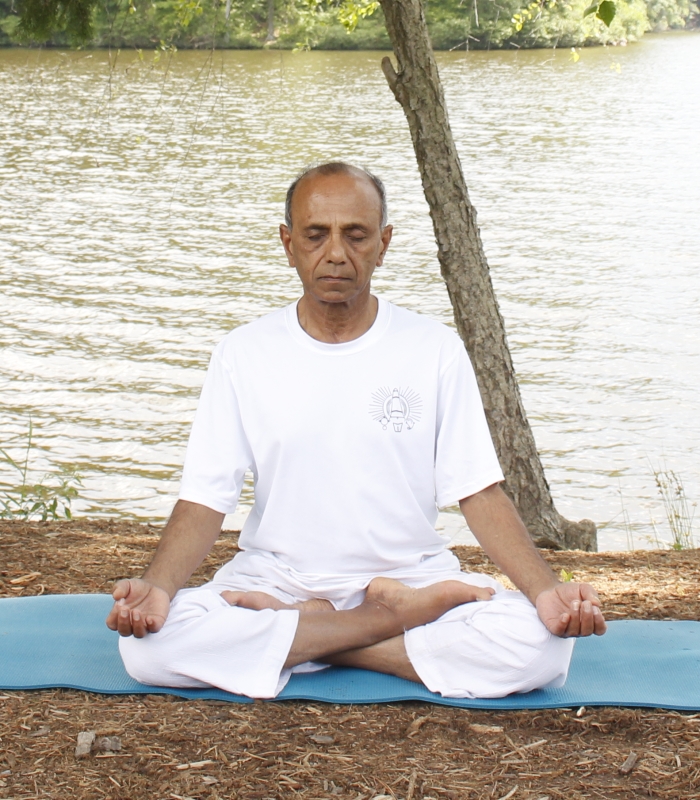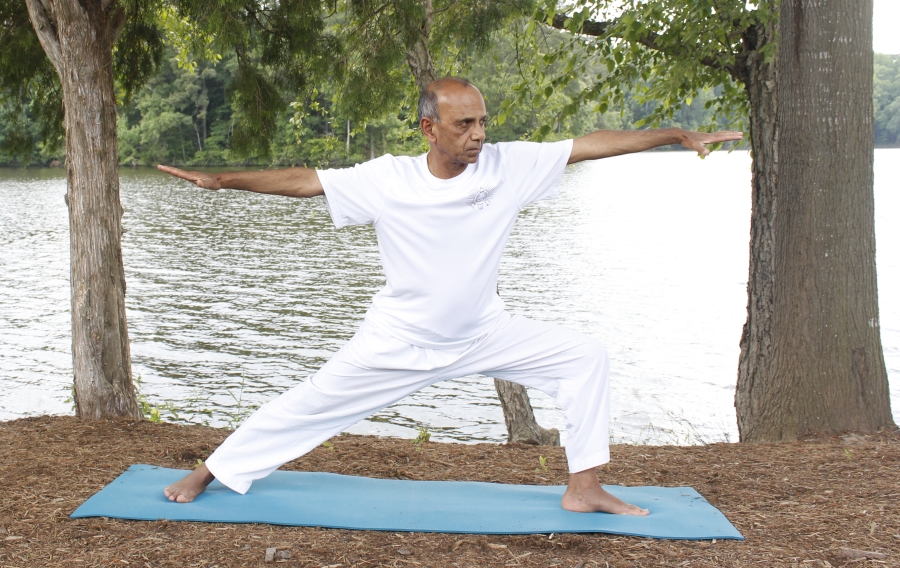
Padmasana (Lotus Pose)
For most people, the word “yoga” is synonymous with the physical aspect of yoga involving the practice of asana (yoga postures) only. In most yoga classes taught in gyms or fitness centers, the entire duration of the class is usually spent in an intense practice of asanas. Some of the more physically oriented yoga styles include Ashtanga Yoga, Power Yoga, or Flow Yoga etc,. Toward the end of the class there is usually a brief (about five minutes) period devoted to “shavasana” or relaxation. The main objective of these classes is to achieve physical fitness.
Asana, however, is only one of the eight limbs of yoga as given by Sage Patanjali over two thousand years ago in the Yoga Sutras. The Yoga Sutras by Patanjali, as you may know, is the most authoritative and revered text that contains the underlying concepts of yoga. The eight limbs of yoga as given in the yoga sutras are – yamas, niyamas, asana, pranayama, pratyahara, dharana, dhyana and samadhi.
Out of a total of 195 sutras in the above text, Patanjali has devoted only three sutras to the topic of asana. In this article, I would like to probe a little deeper into the meaning, concept and the practice of asana as given by Patanjali.
Derivation and meaning of the word “asana”
The Sanskrit word “asana” is derived from the root word “aas” (आस्) which means “to sit”. The word “asana” thus refers to a sitting posture. In fact, the word asana also applies to the object that you are sitting on. So, if you are sitting on a yoga mat, the mat is your “asana”. If you are sitting in a chair, the chair is your asana. Some of the commonly practiced seated meditative postures include Sukhasana (easy pose), Siddhasana (adept pose), Swastikasana, Vajrasana (diamond pose) and Padmasana (lotus pose).
Asana defined
Let us start first with the definition of asana. Patanjali provides the definition of asana in sutra 2.46 – “स्थिरसुखमासनम्॥४६॥ sthira-sukham-āsanam ॥46॥” – “asana must be steady/firm and comfortable” – (sutra 2.46). As mentioned above, in the context of Patanjali’s Yoga Sutras, asana meant a sitting posture used for mediation. While sitting in meditation it is important that one maintain a very steady pose, without any shaking or trembling, and also the asana must be comfortable so you can maintain the pose withour pain or discomfort for the entire duration of meditation.
Evolution of the modern concept of asana

Virabhadrasana (Warrior2)
Practicing asana
Letting go of active effort
The first part of the sutra states that we should let go of any active effort while in a yoga posture. This means that even though we may maintain the intention of deepening the experience of each posture, at no time should we exceed the limits of our body’s strength and flexibility. This is a very key component of our yoga practice as we need to keep the practice very safe and enjoyable. I always add that while holding a pose, we should be able to smile comfortably. After all, yoga is meant to heal the mind and body; by exerting active effort, we might hurt ourselves, thus defeating the very purpose of yoga.
Absorption in the endless
The second part of the sutra lends itself to a couple of different interpretations. The word ‘samapatti’ means ‘samadhi’ or total absorption. ‘Ananta’ means endless or infinite etc. Whereas the first part of the sutra involves experience at the physical level, the second part refers to a state of the mind. One interpretation is that while maintaining a posture, we should merge with the endlessness of space, for example. The second interpretation is that we should get completely absorbed in the total experience of the posture. The word ‘samapatti’ implies that the mind is so deeply engrossed in the experience of the stretch that no other thoughts enter the mind. I personally prefer this second interpretation of the sutra as it allows one to become fully mindful of the asana and its experience. This will help us keep the asana relaxed and steady. The third interpretation refers to the mythological meaning the word ‘ananta’ which is a “thousand-hooded snake” which keeps the earth and the entire planetary system stable by holding each one on one of its hoods. The meaning of ananta as snake naturally leads to another interpretation of the word as referring to the serpent-like Kundalini lying dormant at the base of the spine. As per this meaning, while holding the posture, one should meditate on the Muladhara chakra, at the base of the spine, which is the location of this Kulndalini power commonly represented as a snake coiled three and a half times.
Actually, I would think that one could pick any one of these methods of focus while holding a pose and it will lead to a steady and comfortable pose.
In summary, then, an asana is defined as a steady and comfortable yoga posture. Even though Patanjali intended this definition for sitting, meditative postures, it can be easily extended to all the yoga postures practiced today as part of any Hatha Yoga routine. To attain this level of comfort and steadiness, one needs to let go of any active effort and get completely absorbed in the total experience of the posture, that is, meditating on the experience. This level of mindfulness will lead to asana practice being very safe and thoroughly enjoyable.
I would love to receive your feedback – so please enter your comments in the comment box at the end of this blog post.
Great post Subhash – thank you!
Thanks, Laura, glad you liked the post.